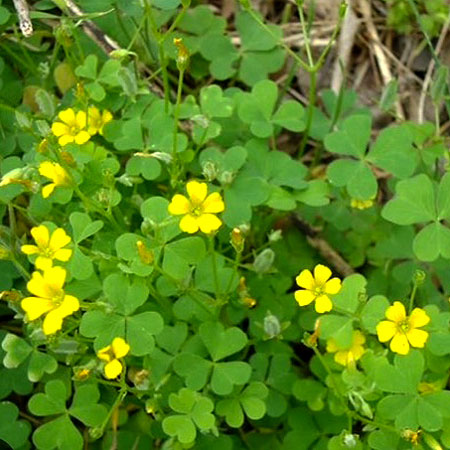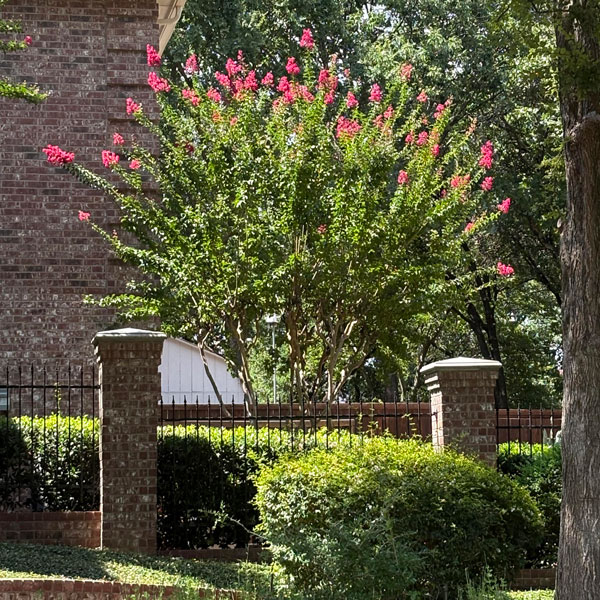Q&A – Ask Neil: August 7, 2025
(Please read these instructions carefully.)
Before you post your question, please look at recent issues to see if someone else has already asked it. You might find your answer there.
How to submit your question…
(Note: You may need to allow a pop-up window to come up in order to get the link for sending your photo(s). If you have already submitted your question and didn’t see the pop-up window, please click here.)
• Click the link provided below to post your question. After you submit your question, a new window will pop up giving you the address to which you can e-mail a SHARP, HIGH-RESOLUTION PHOTO to accompany your question. Please DO NOT SEND THUMBNAIL PHOTOS in case I need to zoom in to see things.
• Click here to post your question.
• Please ONLY POST YOUR QUESTION ONE TIME. We can only accept a set number of questions each week, and when we get duplicates it costs other people their chances.
• One question per reader, please.
• Please use this only for posting questions – not for standard emails.
• Watch for your answer in the following week’s e-gardens.
• I choose those of greatest general interest. For example, plant IDs seldom make the cut.
• I must have your first name or initials.
• I must have your city or county. (Texas is a very large state.)
Important favor: I’ve been covered up so far this year with questions about live oaks losing chunks of bark. Rather than continuing to answer the same questions weekly, I’d ask that you look back to previous issues. You’ll find several replies that I’ve posted. Thanks!
QUESTION 1
WHAT HAS CAUSED ALL BLOOMS ON THIS ONE STALK OF MOY GRANDE HIBISCUS TO HAVE COLORED VEINS, AND HOW CAN I PROPAGATE IT?
Question: These Moy Grande hardy hibiscus plants have been in my landscape for 10 years. Every bloom all that time has been the same. This year, one stalk has white blooms with colored veins. Why, and what do I need to do to get a new plant from this stalk? Chris P., College Station.
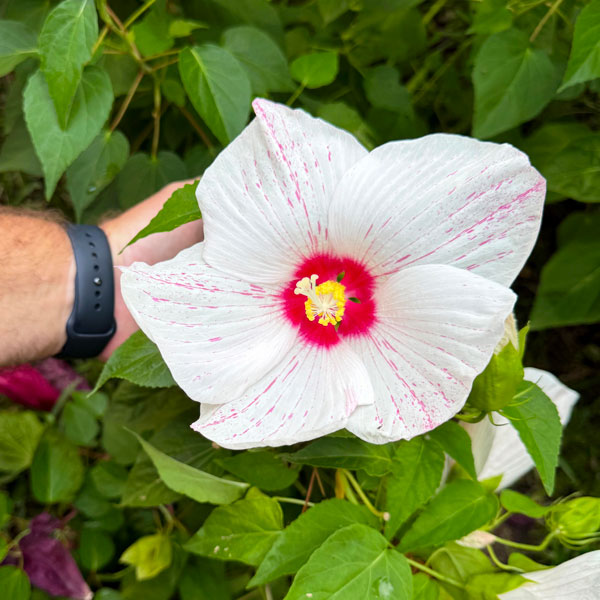
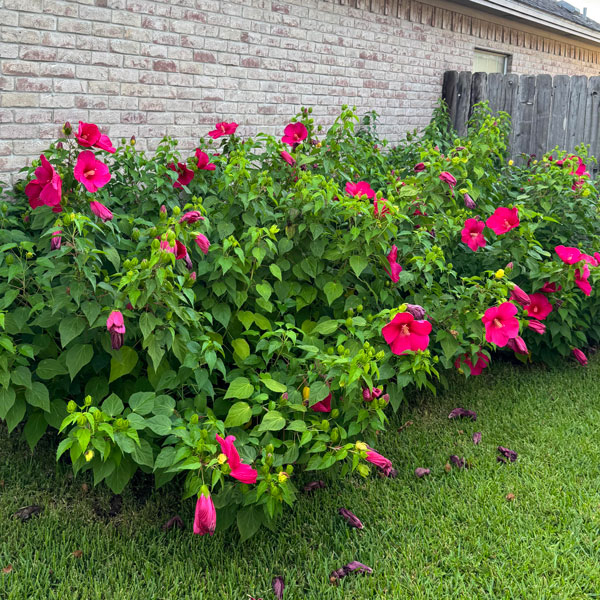
Images clickable for larger views.
Answer: Prof. Moy did his hybridizing at the San Antonio Botanic Garden, and my friends there were excited when the original red form was introduced. This one stalk is obviously a mutation. What we don’t know is how stable it is. Hardy hibiscus tops, of course, die to the ground with the first freeze, so the concern will be whether this mutation occurred within the below-ground crown or above ground level. If the former, that part of the plant will sprout back out again next spring with the same white flowers. If not, all the flowers would go back to being red. You would want to monitor the stability of the mutation. It’s not a good thing to bring unstable mutations into common use. That’s the problem we see with Sunshine ligustrums and some of the variegated varieties of euonymus – branches revert to solid green.
Normally you would dig and divide a hardy hibiscus clump to propagate it, but in this case, you don’t know whether you would get any of the white form or not. The way to perpetuate this one for sure would be to take cuttings from the stalk as soon as possible, before it starts to die back for fall. Root 5-in. cuttings in a greenhouse propagation bench with high humidity. It might help to dip them in rooting hormone powder before sticking them into 6-in. pots filled with a mixture of half peat moss and half perlite.
To be candid, I have never tried cuttings of hardy hibiscus this late in the season. It might be easier to air layer the stem to allow it to form roots before you severed it from the base. That’s what we do with plants that are difficult to root from cuttings. There are plenty of examples of how to do that online. I’ll let you pick it up from here.
QUESTION 2
WHAT CAUSED THIS DAMAGE TO THE BARK OF MY CRAPE MYRTLE?
Question: What caused this damage to the trunk of my crape myrtle? I have a reputable company caring for my lawn, and I am sure they didn’t do damage with their trimming. Please advise. Peggy N., Denton.
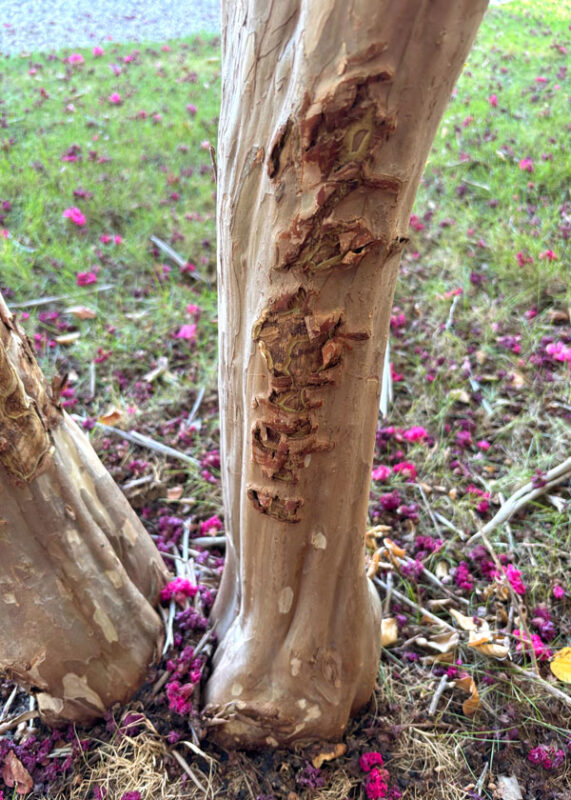
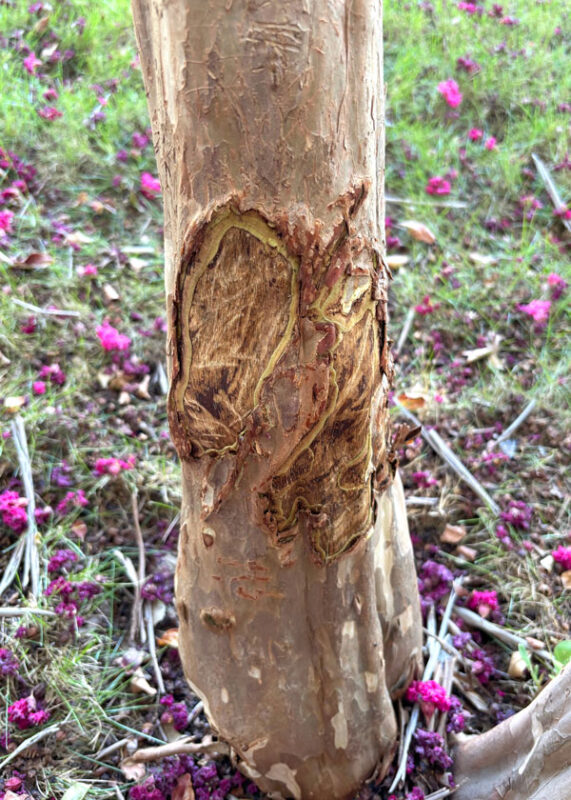
Images clickable for larger views.
Answer: This looks like squirrel damage. They will gnaw on the bark of crape myrtles in winter, both to keep their teeth sharpened, also for the sap that comes from the wood. They rarely totally girdle the trunk with their chewing. Damage like this is insignificant. Just move on. The tree is in the process of healing.
QUESTION 3
WHEN SHOULD I APPLY PRE-EMERGENT FOR WOOD SORREL OXALIS?
Question: In my area, when should I put out pre-emergent for wood sorrel (oxalis)? What type would be best? James D., Montague.
Answer: It is a cool-season weed that germinates in fall and hangs around all winter and spring (and summer – ugh). Gallery would be the best pre-emergent for a broadleafed weed like that.
Honestly, I think a more cost-effective way to keep it out of your landscape would be to use a broadleafed weedkiller spray (containing 2,4-D) as soon as you see it growing, whatever the season. Have a 2-gal. tank sprayer that you dedicate just to that type of herbicide, and be prepared to spray at any time. Oxalis leaves are waxy, so include one drop of liquid dishwashing detergent with each gallon of spray. That will help the herbicide stick to the leaves.
QUESTION 4
WHAT SHRUB WOULD GIVE US PRIVACY WITHOUT OVERGROWING ITS SPACE?
Question: These privets have taken over the back bed and are crowding the patio. Is there a tree we can plant across the back for privacy that won’t get so huge? The bed is 6 ft. wide. Shelly S., Kendall County.


Images clickable for larger views.
Answer: Before I answer, please let me speak to all other readers. I hope you will notice how lovely this landscape is –how beautifully it flows. The curves meld into one another naturally and gracefully. Well done, Shelly! What a great example.
To your answer, I think of two hollies. (People who have read me very long knew I’d go there.) Willowleaf holly (also sold as “Needlepoint”) grows to 8-10 ft. tall and 8 ft. wide, but it can be trimmed to fit into the space you have available. It is available in a variety of nursery container sizes, so you would be able to buy larger plants and then start training them to fit your needs.
Or Oakland hollies. (See photo example in Steve Huddleston’s story on Osmanthus this issue.) They grow to 10 ft. tall and 6 ft. wide (or at least could very easily be maintained at that size or even slightly narrower). They are from a breeding program that involved Mary Nell hollies, so you’ll notice their leaves are larger. The plants themselves are stately.
I caution you with all new hollies to be prepared to water them by hand for their first 2-3 summers. They don’t wilt to warn you when they’re getting dry. I use a water wand and a bubbler with the water turned full flow, and I give them the same amount of water as the container size from which they were planted. For example, a 20-gal. plant gets 20 gallons of water. I repeat every couple of days all summer.
QUESTION 5
WHAT IS CAUSING THIS BARK LOSS ON OUR LIVE OAK?
Question: One of our live oaks has bark damage that appears like an animal has been stripping the bark off, but we never see bark on the ground around the tree. It happened the first time a year ago and I sprayed the tree with pruning sealant. Brian M., Austin.
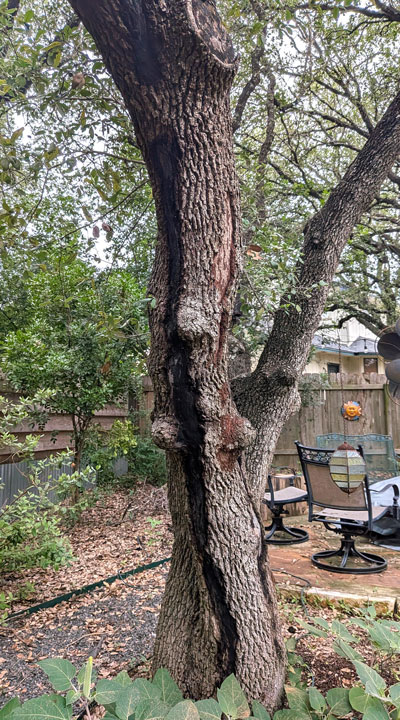
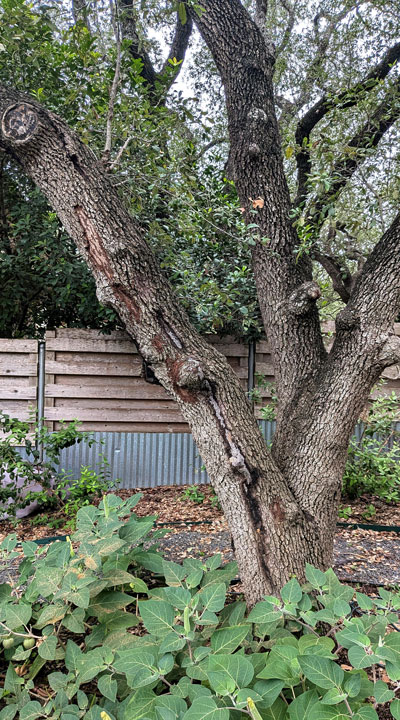
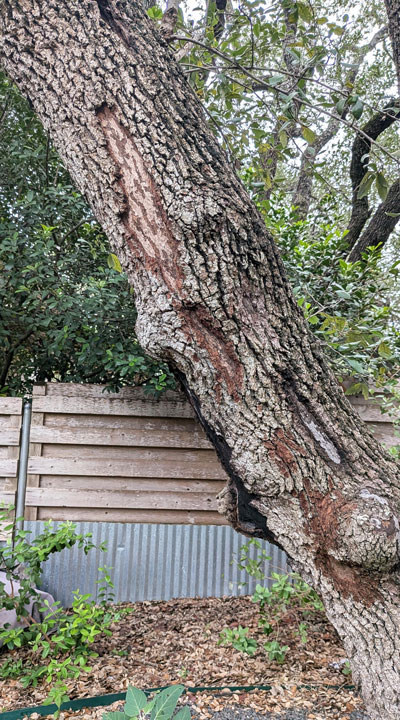
Images clickable for larger views.
Answer: Interesting questions, and right off the top I’m going to suggest that you get a certified arborist to examine your tree closely. He or she may have other and better ideas than I do.
On one hand I wonder about radial shake – the damage done back in February 2021 by the extreme cold. Many live oaks lost a majority of their bark and subsequently died. Ever since we’ve been seeing trees still showing signs of bark pieces falling off. So, there is that, but I’m not convinced that it’s involved.
Your middle photo is like a “connect-the-dots” of prior limb removals. That made me wonder if decay had set into the trunk from one of the branches and is now spreading up or down the trunk between them. That’s not uncommon, but I can’t really tell from photos. That’s where the arborist would be able to help us. I’m curious why so many branches had to be removed.
Looking up through your photos it appears that the trees have overall thin canopies. Again, that could point to leftover cold damage. I can’t tell from the photos.
I will tell you that it appears that decay may be developing. That’s as judged from the photo (first photo) with the black-sprayed line running down the trunk. That alone is cause to have a certified arborist out to examine the tree. The International Society of Arboriculture has a spot on their website to help you locate a certified arborist.
QUESTION 6
WHY WOULD ONE AUCUBA BE LEGGY?
Question: Why would one of three Gold Dust aucubas be leggy? They were planted three years ago 4-5 ft. apart. They all get the same water and feeding. What can I do to help it fill out? Patrick M., Plano.
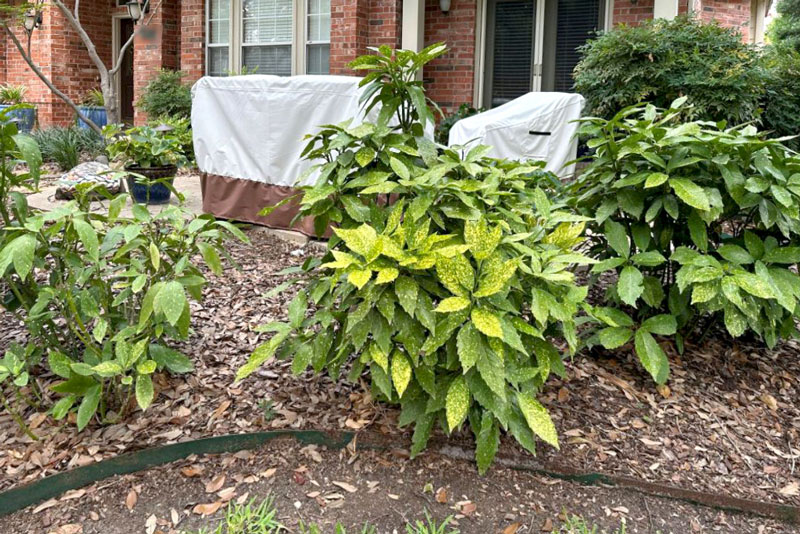
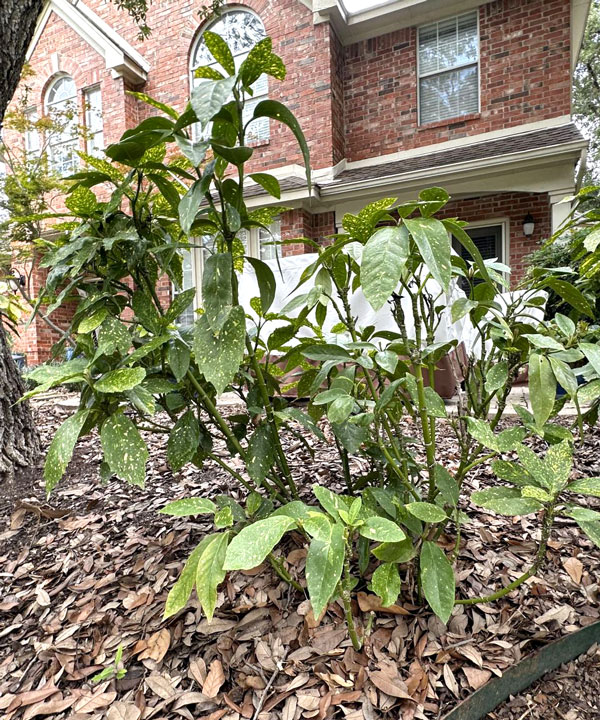
Images clickable for larger views.
Answer: They may all be getting the same watering and feeding regime, but looking at them and the soil around them, my guess would be that you need to ramp both up a bit. The plants are wilted and there are a lot of oak leaves on the ground. I can’t tell if those are left over from last fall and winter or if they’re current. I’d suggest applying an all-nitrogen, lawn-type fertilizer with 30 to 40 percent of its nitrogen being in slow-release form. I would supplement that with a water-soluble, high-nitrogen fertilizer like you might use on patio containers or greenhouse plants, and I would apply that weekly for the next month. See if you can promote some new growth by early fall. Trim that lanky shoot down into the main canopy to conceal it. This is happening on the shady back side of the plant, so it’s not going to branch as freely back there. That’s to be expected.
A follow-up to Question 5 of July 24 from Melodye C. of Flower Mound in Denton County…
Thank you for fielding the question about my non-blooming crape myrtle last week. I thought you might appreciate an update and get a chuckle out of this.
As I pulled into my driveway yesterday after being away for a few days, I found that she is now blooming!
I guess all it took was threatening her with a note to you (ha!). I don’t remember her waiting to bloom so late in the summer in previous years. In any event, it appears all is well.
If you want to see Melodye’s entire question and my reply, here is a link back to that page.

